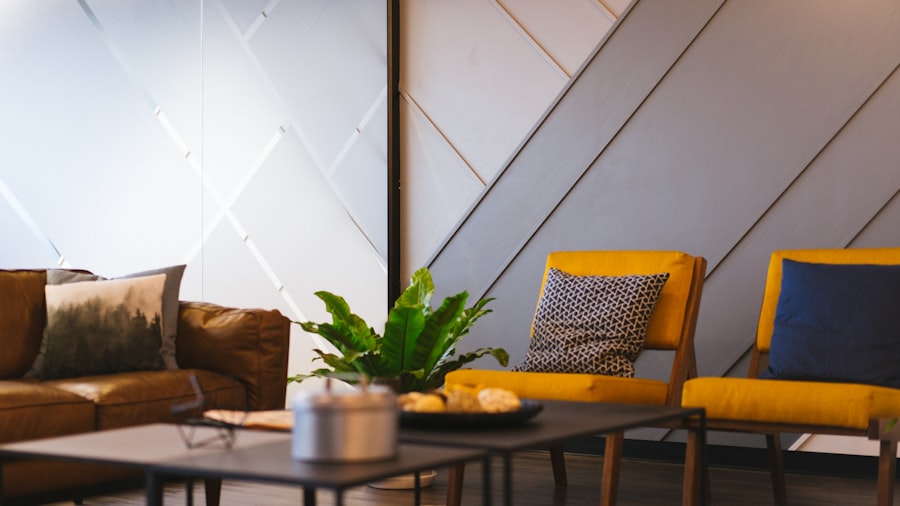Commercial furniture refers to a broad category of furnishings designed specifically for use in business environments, such as offices, retail stores, restaurants, and healthcare facilities. Unlike residential furniture, which prioritizes aesthetics and comfort for personal living spaces, commercial furniture is engineered to withstand heavy use, meet specific regulatory standards, and enhance the functionality of a workspace. The design and construction of commercial furniture often reflect the unique needs of various industries, ensuring that it not only serves a practical purpose but also contributes to the overall ambiance and branding of a business.
The evolution of commercial furniture has been significantly influenced by changing workplace dynamics, technological advancements, and shifts in consumer behavior. For instance, the rise of open office layouts has led to the development of modular furniture systems that promote collaboration while maintaining individual workspaces. Similarly, the increasing focus on sustainability has prompted manufacturers to explore eco-friendly materials and production methods.
As businesses strive to create environments that foster productivity and well-being, the role of commercial furniture becomes increasingly vital in shaping the experience of employees and customers alike.
Key Takeaways
- Commercial furniture refers to furniture designed for use in commercial spaces such as offices, retail stores, hospitality venues, healthcare facilities, and educational institutions.
- The benefits of commercial furniture include durability, functionality, and professional appearance, which can enhance the overall atmosphere of a commercial space.
- Types of commercial furniture include office desks, chairs, reception counters, retail display units, hotel lobby furniture, hospital waiting room seating, and classroom desks and chairs.
- When choosing the right commercial furniture for a space, factors to consider include the specific needs of the space, the style and design of the furniture, and the budget.
- Customization options for commercial furniture may include choosing materials, colors, and finishes to match the branding and design of the commercial space.
Benefits of Commercial Furniture
One of the primary benefits of commercial furniture is its durability. Designed to endure the rigors of daily use in high-traffic environments, commercial-grade furnishings are constructed from robust materials that resist wear and tear. For example, office chairs may feature reinforced frames and high-quality upholstery that can withstand constant movement and frequent cleaning.
This durability not only extends the lifespan of the furniture but also reduces long-term costs associated with replacements and repairs. Another significant advantage is the versatility of commercial furniture. Businesses can select from a wide range of styles, colors, and configurations to create a cohesive look that aligns with their brand identity.
For instance, a trendy café might opt for vibrant, modern seating arrangements to attract a younger clientele, while a law firm may choose classic wooden desks and leather chairs to convey professionalism and trustworthiness. This adaptability allows businesses to tailor their environments to meet specific functional needs while also enhancing aesthetic appeal.
Types of Commercial Furniture

Commercial furniture encompasses a diverse array of products tailored for various settings. In office environments, common types include desks, chairs, conference tables, and storage solutions. Ergonomic office chairs are particularly popular as they promote comfort and support during long hours of work.
Desks may come in various forms, such as standing desks or collaborative workstations, catering to different work styles and preferences. In retail spaces, commercial furniture often includes display fixtures, shelving units, and checkout counters. These pieces are designed not only for functionality but also to enhance the shopping experience.
For example, clothing stores may utilize mannequins and stylish racks to showcase their merchandise effectively, while grocery stores often employ modular shelving systems that can be easily reconfigured based on seasonal promotions or inventory changes. Hospitality spaces also require specialized commercial furniture. Restaurants and cafes typically feature tables and chairs that are both stylish and durable, capable of withstanding spills and frequent rearrangement.
Outdoor seating options are often made from weather-resistant materials to ensure longevity in various climates. Additionally, hotels may invest in lobby furniture that creates a welcoming atmosphere while providing comfort for guests waiting or socializing.
How to Choose the Right Commercial Furniture for Your Space
Selecting the appropriate commercial furniture for a business environment involves several key considerations. First and foremost is understanding the specific needs of the space. For instance, an office that prioritizes collaboration may benefit from open-plan workstations with shared tables and lounge areas, while a more traditional office might require individual cubicles for privacy.
Conducting a thorough assessment of how employees interact within the space can provide valuable insights into what types of furniture will best support their work. Another critical factor is the size and layout of the area. Measuring available space accurately ensures that chosen furniture fits comfortably without overcrowding or obstructing pathways.
Additionally, considering the flow of movement within the space can help determine optimal placements for desks, seating areas, and communal spaces. For example, in a retail setting, strategically positioning display units near entrances can draw customers in while allowing for easy navigation throughout the store. Aesthetic considerations also play a vital role in the selection process.
The color scheme, materials, and overall design should align with the brand’s identity and create a cohesive look throughout the space. Businesses may choose to incorporate their brand colors into furniture choices or select pieces that reflect their industry’s character. For instance, a tech startup might opt for sleek, modern designs with vibrant colors to convey innovation, while a financial institution may prefer more subdued tones and classic styles to evoke stability.
Customization Options for Commercial Furniture
Customization is an essential aspect of commercial furniture that allows businesses to create unique environments tailored to their specific needs. Many manufacturers offer customizable options for various furniture types, enabling companies to select dimensions, materials, colors, and finishes that align with their vision. This flexibility ensures that businesses can achieve a distinctive look while maintaining functionality.
For example, an office may require desks with specific dimensions to fit within an unconventional layout or to accommodate particular equipment. Customizable options allow businesses to choose desk heights that cater to ergonomic needs or select finishes that match existing décor. Similarly, in retail settings, custom display fixtures can be designed to showcase products effectively while maximizing available space.
Moreover, customization extends beyond aesthetics; it can also enhance functionality. Modular furniture systems allow businesses to adapt their layouts as needs change over time. For instance, a growing company might start with a few desks and gradually expand by adding more modules as their workforce increases.
This adaptability not only saves costs but also ensures that the workspace evolves alongside the business.
Commercial Furniture for Office Spaces

In office environments, commercial furniture plays a crucial role in shaping productivity and employee satisfaction. The right selection can foster collaboration while providing individual workers with comfortable spaces to focus on their tasks. Ergonomic office chairs are particularly important as they support proper posture during long hours at a desk.
Features such as adjustable seat height, lumbar support, and breathable materials contribute significantly to employee well-being. Desks in office settings come in various forms to accommodate different work styles. Traditional desks provide dedicated spaces for individual tasks, while collaborative workstations encourage teamwork through shared surfaces.
Standing desks have gained popularity as they promote movement throughout the day and can help reduce health issues associated with prolonged sitting. Additionally, incorporating technology into office furniture—such as integrated power outlets or cable management systems—can enhance functionality and streamline workflows. Storage solutions are another critical component of office furniture design.
Filing cabinets, shelving units, and mobile carts help maintain organization within workspaces while ensuring easy access to essential documents and supplies. Open shelving can also serve as an opportunity for branding by displaying company awards or team photos, contributing to a positive workplace culture.
Commercial Furniture for Retail Spaces
In retail environments, commercial furniture serves not only functional purposes but also plays a pivotal role in creating an inviting atmosphere that encourages customer engagement. Display fixtures are essential for showcasing products effectively; they must be both visually appealing and practical. Retailers often utilize mannequins for clothing displays or glass cases for jewelry to draw attention to specific items.
Checkout counters are another critical element in retail design; they should be designed for efficiency while providing a welcoming experience for customers. A well-designed counter can streamline transactions while offering space for impulse purchases or promotional items. Additionally, seating areas within retail spaces—such as waiting areas or lounges—can enhance customer comfort and encourage longer visits.
The layout of retail furniture is equally important; it should facilitate easy navigation throughout the store while guiding customers toward featured products or sales areas. For instance, creating clear pathways with strategically placed shelving units can help direct foot traffic effectively. Retailers may also consider incorporating flexible furniture arrangements that allow for seasonal changes or special events.
Commercial Furniture for Hospitality Spaces
In hospitality settings such as restaurants and hotels, commercial furniture must balance aesthetics with durability and comfort. Dining tables and chairs should be designed not only for style but also for ease of maintenance; materials that resist stains or scratches are particularly valuable in high-traffic dining areas. Outdoor seating options must be weather-resistant while still providing comfort for guests enjoying al fresco dining experiences.
Lobbies in hotels require thoughtful furniture selection to create welcoming environments where guests feel at ease upon arrival. Comfortable seating arrangements encourage social interaction among guests while providing spaces for relaxation or informal meetings. Additionally, incorporating elements such as coffee tables or side tables can enhance functionality by offering surfaces for drinks or personal items.
In restaurants, the arrangement of tables can significantly impact customer experience; spacing should allow for privacy while still facilitating efficient service from staff members. Flexible seating options—such as booths or communal tables—can cater to different group sizes and dining preferences. The overall design should reflect the restaurant’s theme or cuisine while ensuring that guests feel comfortable throughout their dining experience.
Commercial Furniture for Healthcare Spaces
Healthcare facilities present unique challenges when it comes to selecting commercial furniture due to stringent regulations regarding safety and hygiene. Waiting areas must provide comfortable seating options that accommodate patients and visitors while ensuring easy access for those with mobility challenges. Upholstered chairs with antimicrobial fabrics are often preferred in these settings to promote cleanliness.
Patient rooms require specialized furniture designed for both comfort and functionality; adjustable beds with integrated storage solutions can enhance patient care while maximizing space efficiency. Additionally, healthcare providers often invest in durable examination tables that are easy to clean and maintain over time. In communal areas such as cafeterias or break rooms within healthcare facilities, commercial furniture should prioritize comfort while promoting social interaction among staff members.
Tables should be designed for easy cleaning while providing ample space for meals or meetings. Incorporating elements such as soft seating or lounge areas can create inviting spaces where employees can recharge during their shifts.
Commercial Furniture for Educational Spaces
Educational institutions rely heavily on commercial furniture to create conducive learning environments for students of all ages. Desks and chairs must be designed with ergonomics in mind to support students’ physical well-being during long hours of study. Flexible seating arrangements—such as movable desks or collaborative workstations—encourage group work and foster engagement among students.
Classroom layouts should facilitate interaction between teachers and students while allowing for easy movement within the space. Modular furniture systems enable educators to adapt classroom configurations based on teaching methods or activities being conducted on any given day. For instance, arranging desks in circles can promote discussion-based learning while traditional rows may be more suitable for lectures.
Libraries within educational institutions also require specialized commercial furniture; study carrels provide individual workspaces while communal tables encourage collaboration among peers. Comfortable seating areas with soft furnishings can create inviting spaces where students feel encouraged to read or study independently.
Maintenance and Care Tips for Commercial Furniture
Proper maintenance is essential for prolonging the lifespan of commercial furniture across various settings. Regular cleaning routines should be established based on the materials used; upholstery may require specific cleaning agents while wood surfaces benefit from periodic polishing to maintain their appearance. For upholstered pieces such as chairs or sofas in high-traffic areas like offices or restaurants, routine vacuuming helps remove dust and debris that can accumulate over time.
Spot cleaning spills immediately is crucial; using appropriate cleaning solutions ensures that stains do not set in permanently. Wooden surfaces should be treated with care; avoiding harsh chemicals is essential as they can damage finishes over time. Instead, using mild soap solutions followed by thorough drying helps maintain wood integrity while preventing moisture damage.
In healthcare settings where hygiene is paramount, regular disinfection protocols should be implemented for all surfaces—especially those frequently touched by patients or staff members. Utilizing antimicrobial coatings on frequently used items can further enhance cleanliness efforts. By understanding the unique requirements associated with different types of commercial furniture across various industries—and implementing effective maintenance strategies—businesses can ensure their investments remain functional and visually appealing over time.
When it comes to commercial furniture, finding the perfect height adjustable desk can make a significant difference in the comfort and productivity of employees. This article from Office Interior provides valuable insights on how to choose the right desk for your workspace. Additionally, if you’re looking to upgrade your office furniture, be sure to check out their selection of high-quality products at Office Interior. With a focus on functionality and style, their furniture options are sure to enhance any commercial space. Learn more about their company and services by visiting their About page.


